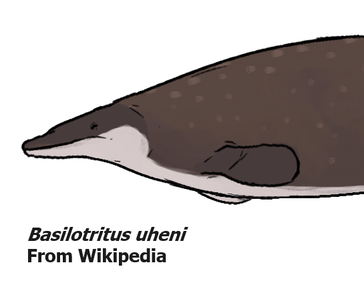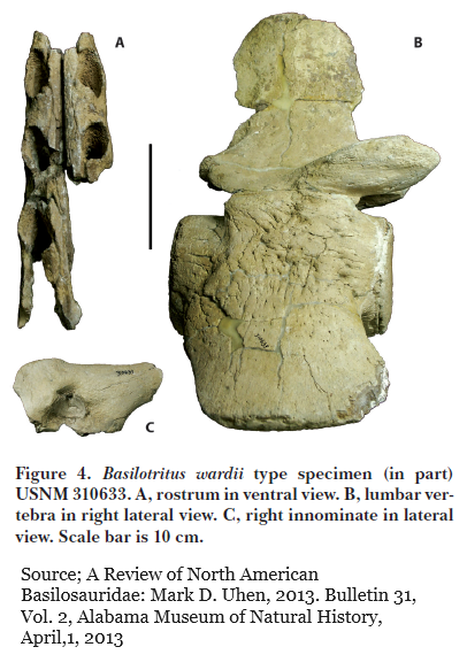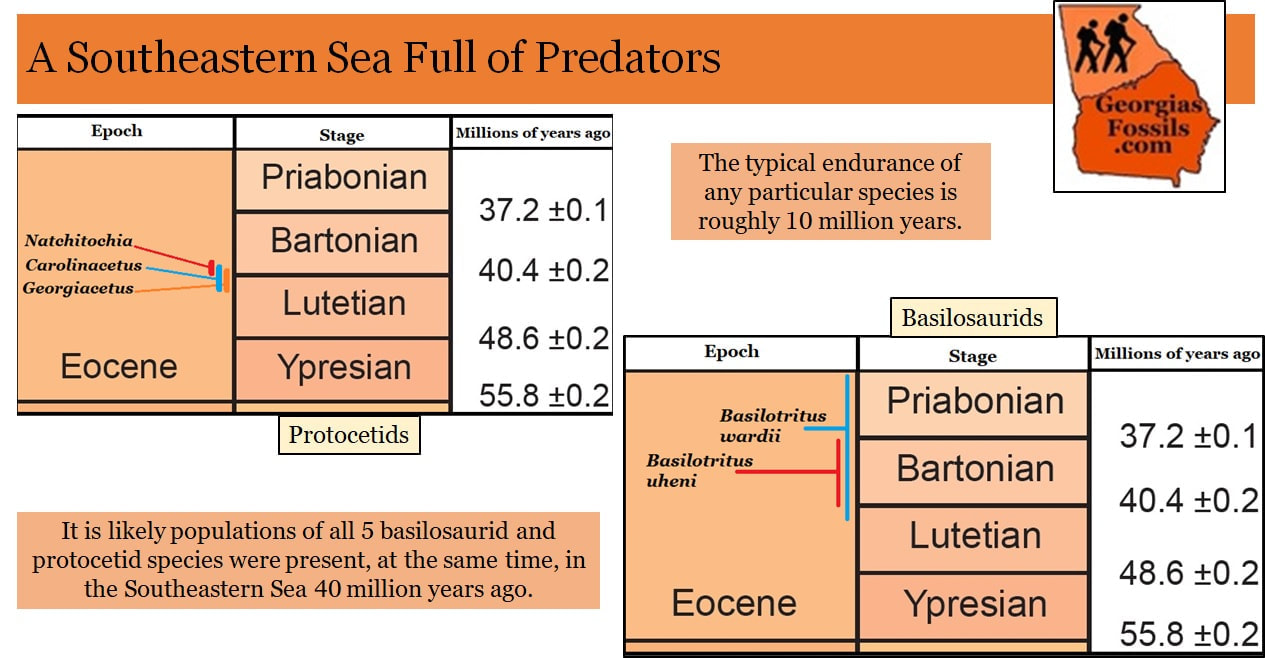12B: Basilotritus
By Thomas Thurman
Within the basilosaurids we'll beging with the genus Basilotritus which was widespread during the very late Bartonian Stage; say 37.5 to 38 million years ago.
Basilotritus has never been reported in Georgia, but was certainly present in the sea which covered the Southeast at this time. It's range in geologic time overlaps with Georgiacetus, Carolinacetus, and Natchitochia.
Basilosaurids are recognized by their typical basilosaurid teeth, largish, triangular, twin rooted molars possessing prominent serrations. The origins of those teeth can be glimpsed in Georgiacetus, whose molars aren’t serrated but show a trend towards that direction.
Basilotritus has serrated molars. The genus is represented by two species; Basilotritus uheni, named in honor of Dr. Mark Uhen, and Basilotritus wardii. Currently these are considered the most primitive members of the basilosaurid family.
Basilotritus uheni was described in March, 2013 by Ukrainian researchers Dr. Pavel Gol'din and Dr. Evgenij Zvonok in a paper published by the Paleontological Society’s Journal of Paleontology and entitled; Basilotritus uheni, a New Cetacean (Cetacea, Basilosauridae) from the Late Middle Eocene of Eastern Europe.
Basilotritus uheni is known from North Carolina, Virginia, Egypt, Germany, Russia and the Ukraine. This find represents Eastern Europe’s earliest known whale. The species shows the beginnings of that elongated vertebra structure which lead towards the great size of later basilosaurids.
Basilotritus wardii (Formerly Eocetus wardii) is a smaller animal, closer to the proto-whales in size and lacking elongated vertebrae. Currently it is only known from the Bartonian Stage of the Eocene and confirmed only in North Carolina and Virginia. The species was originally described by Dr. Marc Uhen in 1999 from the North Carolina specimen. A molar from Basilotritus wardii shows the serrated molars which are typical of the basilosaurid family but lacking in the proto-whales.
The hip structure of Basilotritus wardii is known from a single innominate (hip bone) and partial hind limb, and when compared to Georgiacetus the innominate is “greatly reduced”; to quote Uhen. Further quoting Uhen; it is “clearly not reduced as much as the innominate of other basilosaurids like Basilosaurus, Chrysocetus, and Cynthiacetus.”
Uhen goes on to theorize that the serrated molars, or cheek teeth, which distinguish the basilosaurids emerged before the greater reduction of the hind limbs, the acquisition of additional vertebrae and perhaps even before flukes.
The hip structure of Basilotritus wardii is known from a single innominate (hip bone) and partial hind limb, and when compared to Georgiacetus the innominate is “greatly reduced”; to quote Uhen. Further quoting Uhen; it is “clearly not reduced as much as the innominate of other basilosaurids like Basilosaurus, Chrysocetus, and Cynthiacetus.”
Uhen goes on to theorize that the serrated molars, or cheek teeth, which distinguish the basilosaurids emerged before the greater reduction of the hind limbs, the acquisition of additional vertebrae and perhaps even before flukes.
With the current state of the fossil record, the best professional guess right now is that the genus Basilotritus lacked flukes, but possessed basilosaurid teeth. It is a clear link between the proto-whales like Georgiacetus and the basilosaurids, an intermediate species.
Basilotritus lived between 38 and 37 million years ago, just before the emergence of the fluked Basilosaurus cetoides, and while the hip and partial leg structure of Basilotritus is known, vertebrae from the end of its tail have not yet been recovered and reviewed by science. As Dr. Uhen points out; “Additional, more complete specimens of these and related taxa will be needed to confirm or refute this hypothesis.”
Basilotritus lived between 38 and 37 million years ago, just before the emergence of the fluked Basilosaurus cetoides, and while the hip and partial leg structure of Basilotritus is known, vertebrae from the end of its tail have not yet been recovered and reviewed by science. As Dr. Uhen points out; “Additional, more complete specimens of these and related taxa will be needed to confirm or refute this hypothesis.”
References:
Basilosaurid Evolution
A Review of North American Basilosauridae: Mark D. Uhen, 2013. Bulletin 31, Vol. 2, Alabama Museum of Natural History, April,1, 2013
Basilosaurid Evolution
A Review of North American Basilosauridae: Mark D. Uhen, 2013. Bulletin 31, Vol. 2, Alabama Museum of Natural History, April,1, 2013



